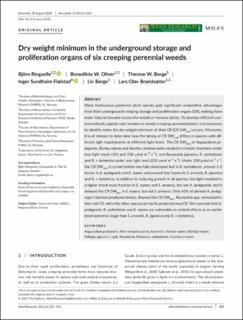Dry weight minimum in the underground storage and proliferation organs of six creeping perennial weeds
| dc.contributor.author | Ringselle, Björn | |
| dc.contributor.author | Oliver, Benedikte Watne | |
| dc.contributor.author | Berge, Therese W. | |
| dc.contributor.author | Fløistad, Inger | |
| dc.contributor.author | Berge, Liv | |
| dc.contributor.author | Brandsæter, Lars Olav | |
| dc.date.accessioned | 2021-10-18T17:51:26Z | |
| dc.date.available | 2021-10-18T17:51:26Z | |
| dc.date.created | 2021-06-28T18:44:57Z | |
| dc.date.issued | 2021-05-06 | |
| dc.identifier.citation | Weed research (Print). 2021, 61 (3), 231-241. | en_US |
| dc.identifier.issn | 0043-1737 | |
| dc.identifier.uri | https://hdl.handle.net/11250/2823748 | |
| dc.description.abstract | Many herbaceous perennial plant species gain significant competitive advantages from their underground creeping storage and proliferation organs (CR), making them more likely to become successful weeds or invasive plants. To develop efficient control methods against such invasive or weedy creeping perennial plants, it is necessary to identify when the dry weight minimum of their CR (CR DWmin) occurs. Moreover, it is of interest to determine how the timing of CR DWmin differs in species with different light requirements at different light levels. The CR DWmin of Aegopodium podagraria, Elymus repens and Sonchus arvensis were studied in climate chambers under two light levels (100 and 250 μmol m−2 s−1), and Reynoutria japonica, R. sachaliensis and R. × bohemica under one light level (250 μmol m−2 s−1). Under 250 μmol m−2 s−1, the CR DWmin occurred before one fully developed leaf in R. sachaliensis, around 1–2 leaves in A. podagraria and E. repens and around four leaves in S. arvensis, R. japonica and R. × bohemica. In addition to reducing growth in all species, less light resulted in a higher shoot mass fraction in E. repens and S. arvensis, but not A. podagraria; and it delayed the CR DWmin in E. repens, but not S. arvensis. Only 65% of planted A. podagragra rhizomes produced shoots. Beyond the CR DWmin, Reynoutria spp. reinvested in their old CR, while the other species primarily produced new CR. We conclude that A. podagraria, R. sachaliensis and E. repens are vulnerable to control efforts at an earlier developmental stage than S. arvensis, R. japonica and R. × bohemica. | en_US |
| dc.language.iso | eng | en_US |
| dc.publisher | John Wiley & Sons Ltd. | en_US |
| dc.rights | Navngivelse 4.0 Internasjonal | * |
| dc.rights.uri | http://creativecommons.org/licenses/by/4.0/deed.no | * |
| dc.title | Dry weight minimum in the underground storage and proliferation organs of six creeping perennial weeds | en_US |
| dc.type | Peer reviewed | en_US |
| dc.type | Journal article | en_US |
| dc.description.version | publishedVersion | en_US |
| dc.rights.holder | © 2021 The Authors | en_US |
| dc.source.pagenumber | 231-241 | en_US |
| dc.source.volume | 61 | en_US |
| dc.source.journal | Weed research (Print) | en_US |
| dc.source.issue | 3 | en_US |
| dc.identifier.doi | 10.1111/wre.12476 | |
| dc.identifier.cristin | 1919108 | |
| dc.relation.project | Regionale forskningsfond Oslofjordfondet: 245824 | en_US |
| cristin.ispublished | true | |
| cristin.fulltext | original | |
| cristin.qualitycode | 1 |
Tilhørende fil(er)
Denne innførselen finnes i følgende samling(er)
-
Divisjon for bioteknologi og plantehelse [532]
Publikasjoner knyttet til ansatte ved Divisjon for bioteknologi og plantehelse -
Divisjon for skog og utmark [521]
Publikasjoner knyttet til ansatte ved Divisjon for skog og utmark -
Publikasjoner fra CRIStin - NIBIO [4575]
-
Vitenskapelige artikler [1416]

